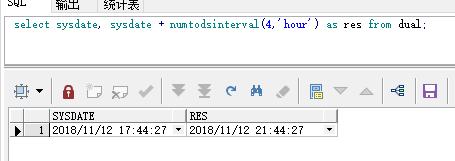oracle分區(qū)表創(chuàng)建(自動按年、月、日分區(qū))實戰(zhàn)記錄
工作中有一張表一年會增長100多萬的數(shù)據,量雖然不大,可是表字段多,所以一年下來也會達到 1G,而且只增不改,故考慮使用分區(qū)表來提高查詢性能,提高維護性。
oracle 11g 支持自動分區(qū),不過得在創(chuàng)建表時就設置好分區(qū)。
如果已經存在的表需要改分區(qū)表,就需要將當前表 rename后,再創(chuàng)建新表,然后復制數(shù)據到新表,然后刪除舊表就可以了。
一、為什么要分區(qū)(Partition)1、一般一張表超過2G的大小,ORACLE是推薦使用分區(qū)表的。
2、這張表主要是查詢,而且可以按分區(qū)查詢,只會修改當前最新分區(qū)的數(shù)據,對以前的不怎么做刪除和修改。
3、數(shù)據量大時查詢慢。
4、便于維護,可擴展:11g 中的分區(qū)表新特性:Partition(分區(qū))一直是 Oracle 數(shù)據庫引以為傲的一項技術,正是分區(qū)的存在讓 Oracle 高效的處理海量數(shù)據成為可能,在 Oracle 11g 中,分區(qū)技術在易用性和可擴展性上再次得到了增強。
5、與普通表的 sql 一致,不需要因為普通表變分區(qū)表而修改我們的代碼。
二、oracle 11g 如何按天、周、月、年自動分區(qū)2.1 按年創(chuàng)建numtoyminterval(1, 'year')--按年創(chuàng)建分區(qū)表create table test_part(?? ID NUMBER(20) not null,?? REMARK VARCHAR2(1000),?? create_time DATE)PARTITION BY RANGE (CREATE_TIME) INTERVAL (numtoyminterval(1, 'year'))(partition part_t01 values less than(to_date('2018-11-01', 'yyyy-mm-dd')));--創(chuàng)建主鍵alter table test_part add constraint test_part_pk primary key (ID) using INDEX;-- Create/Recreate indexescreate index test_part_create_time on TEST_PART (create_time);2.2 按月創(chuàng)建numtoyminterval(1, 'month')--按月創(chuàng)建分區(qū)表create table test_part(?? ID NUMBER(20) not null,?? REMARK VARCHAR2(1000),?? create_time DATE)PARTITION BY RANGE (CREATE_TIME) INTERVAL (numtoyminterval(1, 'month'))(partition part_t01 values less than(to_date('2018-11-01', 'yyyy-mm-dd')));--創(chuàng)建主鍵alter table test_part add constraint test_part_pk primary key (ID) using INDEX;2.3 按天創(chuàng)建NUMTODSINTERVAL(1, 'day')--按天創(chuàng)建分區(qū)表create table test_part(?? ID NUMBER(20) not null,?? REMARK VARCHAR2(1000),?? create_time DATE)PARTITION BY RANGE (CREATE_TIME) INTERVAL (NUMTODSINTERVAL(1, 'day'))(partition part_t01 values less than(to_date('2018-11-12', 'yyyy-mm-dd')));--創(chuàng)建主鍵alter table test_part add constraint test_part_pk primary key (ID) using INDEX;2.4 按周創(chuàng)建NUMTODSINTERVAL (7, 'day')--按周創(chuàng)建分區(qū)表create table test_part(?? ID NUMBER(20) not null,?? REMARK VARCHAR2(1000),?? create_time DATE)PARTITION BY RANGE (CREATE_TIME) INTERVAL (NUMTODSINTERVAL (7, 'day'))(partition part_t01 values less than(to_date('2018-11-12', 'yyyy-mm-dd')));--創(chuàng)建主鍵alter table test_part add constraint test_part_pk primary key (ID) using INDEX;2.5 測試可以添加幾條數(shù)據來看看效果,oracle 會自動添加分區(qū)。--查詢當前表有多少分區(qū)select table_name,partition_name from user_tab_partitions where table_name='TEST_PART';--查詢這個表的某個(SYS_P21)里的數(shù)據select * from TEST_PART partition(SYS_P21);三、numtoyminterval 和 numtodsinterval 的區(qū)別 3.1 numtodsinterval(<x>,<c>) ,x 是一個數(shù)字,c 是一個字符串。把 x 轉為 interval day to second 數(shù)據類型。
常用的單位有 ('day','hour','minute','second')。
測試一下:
select sysdate, sysdate + numtodsinterval(4,'hour') as res from dual;結果:

將 x 轉為 interval year to month 數(shù)據類型。
常用的單位有 ('year','month')。
測試一下:
select sysdate, sysdate + numtoyminterval(3, 'year') as res from dual;結果:

表示小于 2018-11-01 的都放在 part_t01 分區(qū)表中。
五、給已有的表分區(qū)需要先備份表,然后新建這個表,拷貝數(shù)據,刪除備份表。
-- 1. 重命名
alter table test_part rename to test_part_temp;-- 2. 創(chuàng)建 partition table
create table test_part(?? ID NUMBER(20) not null,?? REMARK VARCHAR2(1000),?? create_time DATE)PARTITION BY RANGE (CREATE_TIME) INTERVAL (numtoyminterval(1, 'month'))(partition part_t1 values less than(to_date('2018-11-01', 'yyyy-mm-dd')));-- 3. 創(chuàng)建主鍵
alter table test_part add constraint test_part_pk_1 primary key (ID) using INDEX;-- 4. 將 test_part_temp 表里的數(shù)據遷移到 test_part 表中
insert into test_part_temp select * from test_part;-- 5. 為分區(qū)表設置索引
-- Create/Recreate indexescreate index test_part_create_time_1 on TEST_PART (create_time);-- 6. 刪除老的 test_part_temp 表
drop table test_part_temp purge;-- 7. 作用是:允許分區(qū)表的分區(qū)鍵是可更新。
-- 當某一行更新時,如果更新的是分區(qū)列,并且更新后的列植不屬于原來的這個分區(qū),
-- 如果開啟了這個選項,就會把這行從這個分區(qū)中 delete 掉,并加到更新后所屬的分區(qū),此時就會發(fā)生 rowid 的改變。
-- 相當于一個隱式的 delete + insert ,但是不會觸發(fā) insert/delete 觸發(fā)器。
alter table test_part enable row movement;六、全局索引和 Local 索引我的理解是:
當查詢經常跨分區(qū)查,則應該使用全局索引,因為這是全局索引比分區(qū)索引效率高。
當查詢在一個分區(qū)里查詢時,則應該使用 local 索引,因為本地索引比全局索引效率高。
總結到此這篇關于oracle分區(qū)表創(chuàng)建(自動按年、月、日分區(qū))的文章就介紹到這了,更多相關oracle分區(qū)表創(chuàng)建內容請搜索好吧啦網以前的文章或繼續(xù)瀏覽下面的相關文章希望大家以后多多支持好吧啦網!

 網公網安備
網公網安備